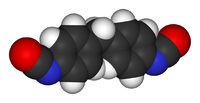
Photo from wikipedia
In this work we characterize personal inhalation and dermal exposures to diphenyl methane diisocyanate (MDI) and other species in polymeric MDI (pMDI) formulations during spray polyurethane foam (SPF) insulation at… Click to show full abstract
In this work we characterize personal inhalation and dermal exposures to diphenyl methane diisocyanate (MDI) and other species in polymeric MDI (pMDI) formulations during spray polyurethane foam (SPF) insulation at 14 sites in New England. We further assess the adequacy of current workplace practices and exposure controls via comparative urinary biomonitoring of the corresponding methylene diphenyl diamine (MDA) pre- and post-shift. MDI and pMDI are potent dermal and respiratory sensitizers and asthmagens, strong irritants of the skin, eyes, and the respiratory tract, and may cause skin burns. This study is the first comprehensive report to-date on the work practices, inhalation and dermal exposures to isocyanates and effectiveness of existing controls during SPF applications. Breathing zone exposures to 4,4' MDI (n = 31; 24 sprayers, 7 helpers) ranged from 0.9 to 123.0 μg/m3 and had a geometric mean (GM) of 13.8 μg/m3 and geometric standard deviation (GSD) of 4.8. Stationary near field area samples (n = 15) were higher than personal exposures: GM, 40.9 (GSD, 3.9) μg/m3, range 1.4-240.8 μg/m3. Sixteen percent of personal air samples and 35% of area samples exceeded the National Institute for Occupational Health and Safety's (NIOSH) full shift recommended exposure limit (REL) of 50 μg/m3, assuming zero exposure for the unsampled time. 4,4' MDI load on the glove dosimeters had a GM of 11.4 (GSD 2.9) μg/glove pair/min, suggesting high potential for dermal exposures. Urinary MDA had a GM of 0.7 (GSD, 3.0) μmol MDA/mol creatinine (range, nd-14.5 μmol MDA/mol creatinine). Twenty-five % of urine samples exceeded the Health and Safety Executive (HSE) biological monitoring guidance value (BMGV) of 1 μmol MDA/mol creatinine. We further report on field observations regarding current exposure controls, discuss implications of these findings and opportunities for improving work practices to prevent isocyanate exposures during SPF insulation.
Journal Title: International journal of hygiene and environmental health
Year Published: 2019
Link to full text (if available)
Share on Social Media: Sign Up to like & get
recommendations!